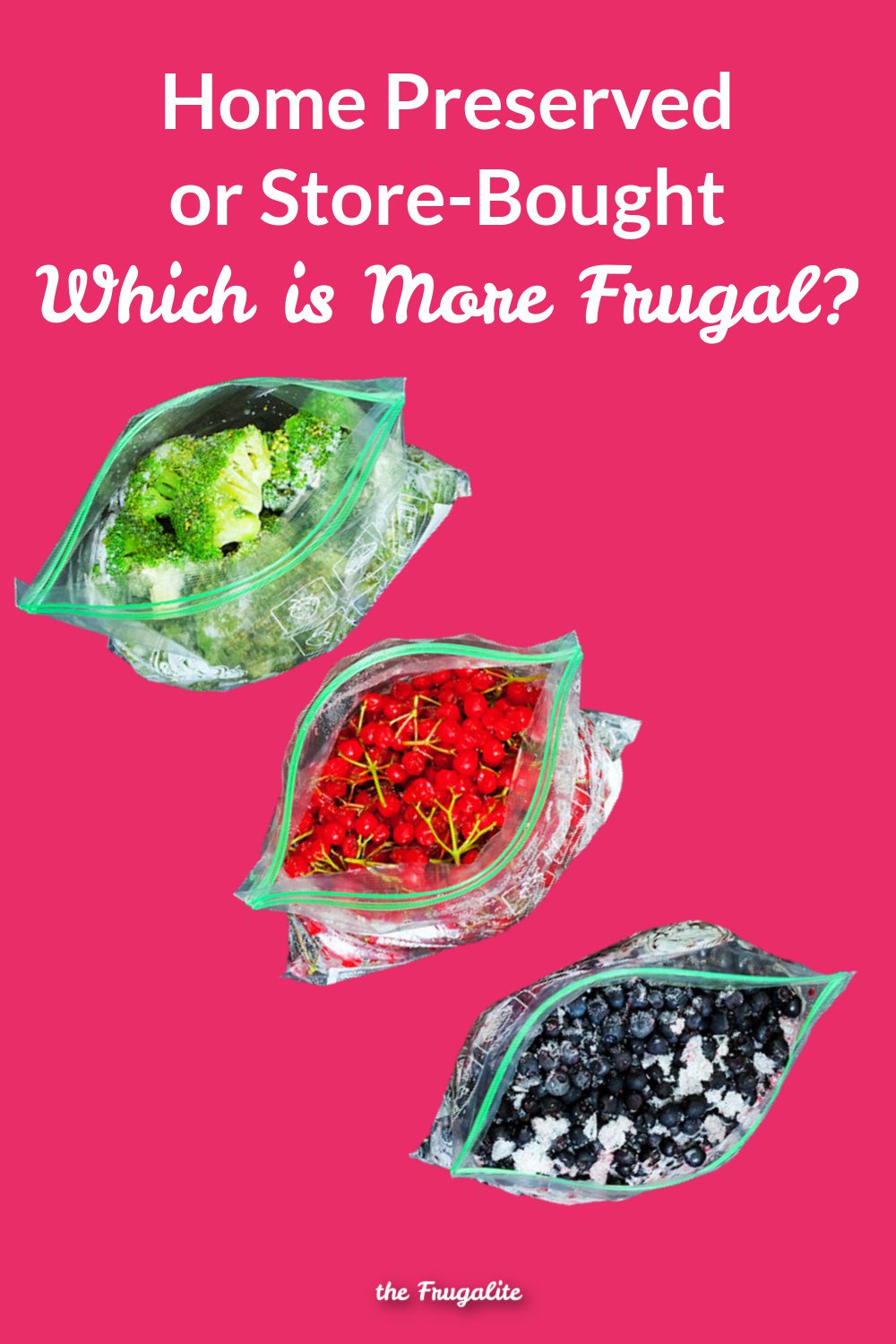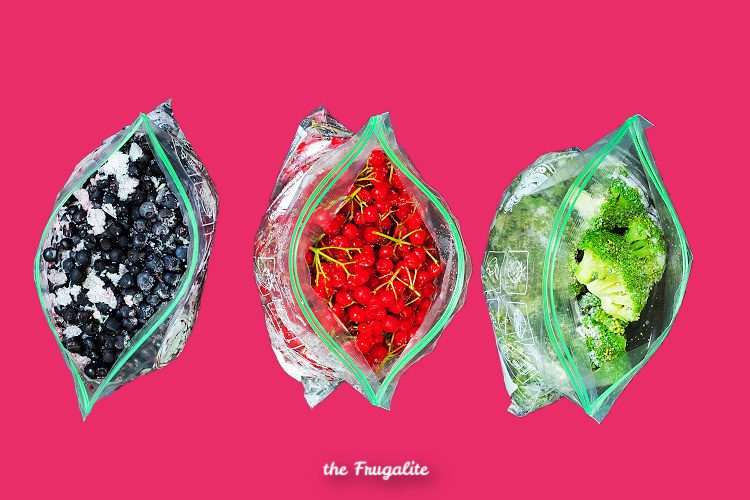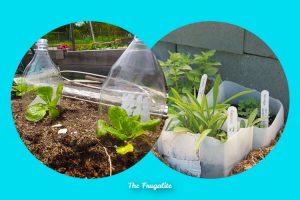(Psst: The FTC wants me to remind you that this website contains affiliate links. That means if you make a purchase from a link you click on, I might receive a small commission. This does not increase the price you’ll pay for that item nor does it decrease the awesomeness of the item. ~ Daisy)
I’ve always taken it for granted that home-preserved food is healthier, more frugal, and generally more desirable than store-bought. But is it true? I’ll put pencil to paper in this article, comparing costs and health concerns from ingredients and processing perspectives. My figures come from a local store. Your prices might vary, of course.
I’ve been preserving my food since 2012. Technically, I have been since I was 10. My grandmother insisted I help her in the kitchen. I was the flunkie: I washed jars, sorted vegetables, snipped ends, and ran to the store multiple times per day for whatever she needed. Little did I know how valuable these lessons would be! Now, as I’ve said, I preserve my own. I source it from several places: my garden, my CSA, and the farmer’s markets.
Spaghetti with meat sauce
Pressure Canned: One batch = nine-pint jars.
Ingredients:
- Tomatoes, bell peppers: $0 sourced from my garden
- Ground beef, 5 lbs @ $3.50/lb: $17.50, farmer’s market
- Herbs: parsley, oregano, garlic, bay leaf $0 from my garden
- Sugar & vinegar: a few tablespoons per batch. Call it $1
- Total: $18.50/9= $2.06 per pint
Note that having to buy ingredients will raise the cost. This recipe requires 5 lbs, plus 24 oz of tomato paste, made beforehand.
Store bought:
- We’ll use the same meat: $17.50
- Ragu pasta sauce, 24 oz. $2.19
- Total: $19.69/9 = $2.19/ pint
Organic store-bought:
- Newman’s Own organic tomato basil pasta sauce: $3.39/ 23.5 oz
- Total: $20.89/9 = $2.32/pint
Not a huge price difference between the three, and making my own is usually 4-5 hours of labor. Canning supplies do cost initially, but I’ve used my Presto canner and jars for nine years.
Consider, However, What Else Goes Into Processed Food
Ragu pasta sauce contains:
Tomato Puree (Water, Tomato Paste), Salt, Olive Oil, Sugar, Dehydrated Onions, Dehydrated Garlic, Spices, Garlic Powder, Onion Powder. https://www.ragu.com/our-sauces/old-world-style-sauces/old-world-style-traditional-spaghetti-sauce/
Not bad. Checking the nutrition information shows 400 mg of sodium and 600 mg of potassium! Other than some calcium and iron, there’s not much else. Tomatoes contain a lot of potassium, but why is there so much sodium? The Ragu site doesn’t say anything about preservatives, but processed foods usually contain a great many preservatives and dyes. Even Newman’s Own sauce contains 380 mg of sodium in addition to:
Organic Tomato Puree (Water, Organic Tomato Paste, Citric Acid), Organic Diced Tomatoes, Organic Extra Virgin Olive Oil, Organic Basil, Organic Carrot Puree, Organic Onion, Sea Salt, Organic Garlic, Organic Black Pepper, Organic Fennel. [source]
The term “organic” is generally highly misunderstood
At its most basic, organic simply means “containing carbon.” As it relates to food production, it means “of, relating to, yielding, or involving the use of food produced with the use of feed or fertilizer of plant or animal origin without employment of chemically formulated fertilizers, growth stimulants, antibiotics, or pesticides” There are several pesticides, for example, copper fungicide, that are considered organic by virtue of its derivation.
Organic farmers are allowed to use such pesticides and still retain their certification. So, in short, that term may not mean what you think it means. Grocery stores charge a great deal more for things in the Organic Produce section. Are you truly getting what you’re paying for when you shop? Frugalites want to know!
Regarding the items we’re evaluating, those on low sodium diets may wish to consider store-bought sauces carefully. For myself, I’ll trade the labor for the lack of strange chemicals. And the pennies I’m saving make dollars over time!
Vegetables
I freeze most of mine, which is a very cheap and easy way to preserve them. I use 1-quart freezer bags to freeze my favorites: broccoli, cauliflower, and carrots. Although I freeze a few other vegetables, we’ll focus on those three.
Cauliflower: 2 heads @ $3 each = $6, sourced from the farmer’s market. I do get these in my CSA, but I really like cauliflower, so I buy more for freezing. Total was 4 quart bags = $1.50/ bag. I usually get six meals per bag which results in a cost of $0.25/serving.
Store-bought:
- Bird’s Eye Fresh Frozen Select: 14.4 oz., $2.39. The label estimates five servings, so $0.48/serving.
- Pictsweet Farms Farm Favorites Steam’ables: 10z, $2.29. The label says 3.5 servings, so we’re paying $0.65 per serving.
- Food Club frozen: 1 lb., $2.19. 5 servings = $0.44/serving.
My broccoli and carrots come from my CSA box, which is $25 per box and usually contains 5-6 items. I eat the fruit fresh and preserve the vegetables that freeze well. It’s a bit difficult to quantify, but from the farmer’s market, broccoli is usually $1/head and carrots $2/lb., which results in a 1-quart bag of each, six meals. So, home preserved broccoli is $0.17/serving, and carrots are $0.33. Also, I use the entire broccoli head, including the stem. That part is good for soup-making and doesn’t hurt my plate either.
Store-bought broccoli:
- Birdseye premium broccoli florets: 10.8 oz., $2.39. The label says 3.5 servings, so $0.68 per serving.
- Cascadian Farm Organic: $2.79/1 lb. That’s 16 oz., which is a one-quart freezer bag. So, 6 servings @ $0.47 each.
- I’ve also seen no-name broccoli, 12 oz., in my store for $0.99. So four meals for $0.25 each.
Store-bought carrots:
- Pictsweet Farms Simple Harvest sliced carrots, 12 oz./$1.69. Estimated four servings, so $0.42/serving.
- No-name frozen carrots $1.19/14 oz. Let’s figure about four servings, so $0.30/serving.
It seems that when it comes to carrots, it can be cheaper or equivalently priced to buy in the store rather than sourcing locally and processing one’s own. For broccoli and cauliflower, home preserved wins the price comparison. Happily, vegetables in the poly bags are not processed and tend to be the higher grade product, unlike canned items. Those will have sodium added, at least.
Salsa
Since I grow all of the ingredients, the cost of the product is labor only. My recipe calls for tomatoes, bell and chili peppers, garlic, onions, and a few miscellaneous herbs. Having to purchase ingredients will raise the cost accordingly, of course. My recipe usually makes 18 pints and takes a full day, but again, I know every ingredient in my jars. There are no added dyes or preservatives, much less a crazy amount of added salt. As a bonus, the taste varies depending upon which varieties of each ingredient I’ve grown. You won’t find this variety in industrially produced food, where the goal is to taste the same no matter where it’s bought and by whom. I prefer the wonder of variety, though I grant this is subjective.
Here’s Daisy’s “recipe” for Hodge-Podge Salsa.
Home preserved food is cost-effective AND better for your health
Through the illuminating mechanism of mathematics, we’ve discovered that growing and processing one’s food can be very cost-effective. At the very least, it’s equal to store-bought foods and, in two of the cases we’ve examined, spares us the ill effects of processed. I also find that working with my food reconnects me to the source of my food. I’ve learned to eat and preserve in season rather than by convenience.
As other articles have pointed out, eating in season gives our bodies nutrients needed at that time. Foods that have traveled great distances were likely picked before fully ripe and sprayed with chemicals to keep them from becoming too ripe before reaching their destination. Therefore, there are less developed nutrients in addition to chemicals.
The supply chain problems we’ve had are likely to continue. With that, there’s no longer any guarantee of availability, so I prefer to source locally as much as possible and preserve for later enjoyment. I find it a very satisfying form of self-care. It’s also much easier on the wallet overall. My single-sized CSA costs me $400 per year for 16 boxes. Between that, the farmer’s market, and my garden, I have all the vegetables, spaghetti sauce with meat, salsa, and a few other things that I require for the year. And none of it contains the excess salt, dyes, or preservatives that store-bought items have.
Isn’t that worth a few hours on the weekend? I think so! What foods do you put up? What methods do you use? What are your favorite things to preserve? Let’s talk about it in the comments.












8 thoughts on “Home Preserved or Store Bought: Which is More Frugal?”
Here’s an insurrectionist thought: Is it possible that the initial criteria of whether home preserved or store bought is more economical .. pales in comparison with the economics of possibly losing 100% of EITHER for food items preserved that require electricity-powered freezing or even lesser demanding refrigeration? Since the WEF globalists ran a simulation in July of 2021 (called Cyber Polygon) of nationwide power outages of undisclosed length, the prospect of successful food preservation under such a threat is no small issue. How likely is such a threat? Consider that the globalists run a simulation of a monstrous pandemic in the fall of 2019 just a few months before Covid-19 was turned loose in the Spring of 2020. Make your own risk assessment judgment.
In the event of such a catastrophe, foods (regardless of whether home preserved or store bought) that are dehydrated, canned or pickled are not vulnerable to such catastrophic loss. A few foods don’t dehydrate well (per the guidance from dehydrate2store.com with both online and book resources) and so exploring some of the other preservation methods is a must. Tammy Gangloff (the guiding light of that website) says that dehydration generally preserves about 90% of a food’s nutrition … where canning only preserves about 50%. I don’t know what the numbers are for pickling.
Some thoughts about dehydration — the French used to sun dry foods by hanging them 30-40 feet up in the air where the breezes would blow bugs away. These days besides electric dehydrators (like the Excalibur, etc) and electric vacuum sealers together with the use of plastic bags and oxygen absorbers, there are plenty of plans to make DIY solar dehydrators. So one can still dry foods even during a long term power outage.
One interesting workaround that the Amish communities use (given their long-standing prohibition for using electricity) is refrigerators powered by either propane or natural gas — more expensive than electric fridges but definitely not vulnerable to a short term power outage. (However … a long term outage might hurt the availabilty of either propane or natural gas.) A search in the books section of Amazon on the phrase LIVING WITHOUT ELECTRICITY will pull up many titles about that entire lifestyle.
In summary, I think that regardless of the source economics of growing or buying foods, both the nutrition percentage saved from whatever best preservation method is possible AND the risk of total loss of any preserved or merely saved foods that require either freezing or simple refrigeration … are hugely significant.
–Lewis
True enough, freezing foods is subject to power loss, although some factors that can mitigate that include a nice, subzero winter when it happens. It’s possible to store food in a snow bank, or even a chest cooler with ice for a short amount of time. Also, freezers will keep food safe for a day or two if the door stays shut, or mostly shut. And as you point out, some foods aren’t suitable for canning, broccoli being one example and cabbage being another. Dehydration assumes you’ll have water available to re-hydrate. There is a great book called Preserving Food Without Freezing or Canning that details a number of traditional techniques for preserving food. Our forebears lived without electricity for quite a long time.
The purpose of my experiment was to determine if going to the trouble of processing my own vs buying convenience foods was more economical and healthier. It is. The end.
Fun fact about cabbage. In my canning book, I adapted my granny’s sweet and sour coleslaw recipe to be pressure canned and it’s delicious.
When my youngest and I lived out in the Algonquin Forest in Ontario, we had frequent power outages in the winter. I bought one of those deck boxes (the kind you can store your chair cushions in) and put a lock on it to keep hungry critters out. We kept our freezer food in plastic tubs, and if the power was out for more than 2 hours, we’d tote them out and put them in the box on our patio.
Some awesome advice in this article and the comments section both!
Is this the book you mentioned?
Preserving Food Without Freezing or Canning: Old World Techniques and Recipes [PRESERVING FOOD W/O FREEZI -OS] Paperback – May 11, 2007
by Deborah Madison
https://www.amazon.com/Preserving-Food-Without-Freezing-Canning/dp/B001TJO778/ref=sr_1_15
Also, when I ran a search on the short title version of that book, Amazon pulled up a ton of related books as well. And of course anything older than six months past the publisher’s release date (at least in the US) is fair game for a free interlibrary loan request.
–Lewis
I’m actually referring to this one:
https://smile.amazon.com/s?k=preserving+food+without+freezing+or+canning&i=stripbooks&crid=G36G3UGKS29M&sprefix=preser%2Caps%2C201&ref=nb_sb_ss_c_2_6_ts-doa-p
Preserving Food Without Freezing or Canning: Traditional Techniques Using Salt, Oil, Sugar, Alcohol, Vinegar, Drying, Cold Storage, and Lactic Fermentation.
There are a ton of techniques and they’re all likely cheaper than convenience foods, not to mention healthier.
One cost not figured in was the cost of power! Frozen foods often require blanching; this takes both boiling water and an ice bath. Steam and water-bath canning both require boiling water. Pressure canning requires boiling water, for extended periods of time. Dehydrating uses electricity or propane, if you are not doing solar dehydrating. All that can add up quickly. Then too, if you are freezing food as opposed to just in time buying, you have extra costs for power usage.
The comfort of knowing exactly what is in your food may outweigh all other considerations; that all depends on your own circumstances.
Costs! Hoo, boy, what a can of worms that can be! In my area (northern VT) ground beef from organic, pasture raised critters is around $10/lb or more, and that is at farmer’s markets. In-store, commercially raised ground beef is around $6-$7 a lb. Farmers market veggies ( not much fruit besides berries) run higher here due to the climate. My CSA offers a year round option for veggies; small option is $137/month and there isn’t enough to eat AND preserve in a weekly share.
So, I garden some, buy at farmer’s markets some, and am lucky to have a locally sourced grocery store nearby. You don’t want to know my costs, you’d have a coronary! Of course, that’s for premium products. If I just bought store brand items it would be less, but so would the quality.
Those are fair points. I didn’t really know how to account for the electricity as a portion of my monthly bill. I also didn’t assign a cost to labor; I make $20/hr on a bad day, but I process food on my “off” time so should I calculate labor costs or just call it a leisure activity?
As for meat costs, you’ve likely realized that I used the cheapest farmer’s market meat I could find. Other vendors did charge more, in some cases a lot more. It’s pretty bad when buffalo meat is about the same as ground beef, I think.
One huge consideration for me is availability, especially in the light of the past year’s supply chain issues. Another board I hang out on had an on the ground reporting thread, and people all over the country were reporting problems obtaining meat of all kinds. Farmers where plowing fields of veggies under because they couldn’t sell to their usual clients and couldn’t afford to pay someone to pick then just donate. Thankfully, living in farm country with CSA access meant that I didn’t have that problem. Making use of my opportunities to store stuff also helped. Granted not everyone has these options, but I can’t save the world.
Thanks for the great points!
Thank you for the info about the book, but I’m having a problem viewing the link. Who is the author?